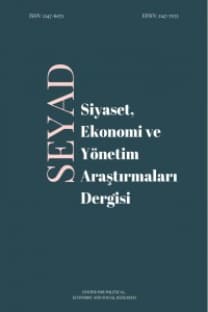SİYASET, EKONOMİ ve YÖNETİM
.
The Relationship between Coal Consumption, Income Level and CO2Emissions in Turkey
Coal Consumption, Income Level, CO2 Emissions Turkey,
___
- Akbostancı, E., Türüt-Aşık, S. ve Tunç, G. İ. (2009), “The Relationship between Income and Environment in Turkey: Is There an Environmental Kuznets Curve?”, Energy Policy, 37, s.861-867.
- Apergis, N. ve Payne, J. E. (2009), “Energy Consumption and Economic Growth in Central America: Evidence from a Panel Cointegration and Error Correction Model”, Energy Economics, 31, p.211-216.
- Apergis, N. ve Payne, J. E. (2010), “Coal Consumption and Economic Growth: Evidence from a Panel of OECD Countries”, Energy Policy, 38, p.1353-1359.
- Atıcı, C. ve Kurt, F. (2007), “Türkiye'nin Dış Ticareti ve Çevre Kirliliği: Çevresel Kuznets Eğrisi Yaklaşımı”, Tarım Ekonomisi Dergisi, 13(2), s.61-69.
- Bates, B. C., Kundzewicz, Z. W., Wu, S. and Palutikof, J. P. (2008), “Climate Change and Water” Technical Paper of the Intergovernment Panel on Climate Change, IPPC Secretariat, Geneva.
- Bildirici, M. E. ve Bakırtaş, T. (2014), “The Relationship among Oil, Natural Gas and Coal Consumption and Economic Growth in BRICTS (Brazil, Russian, India, China, Turkey and South Africa) Countries”, Energy, 65, p.134-144.
- Bozdağlıoğlu, E. Y. ve Çakır, M. (2013), “Economic Growth and Environmental Quality in Turkey: Are They Opposite Concepts?”, International Journal of Economics and Finance Studies, 5(1), p.85-95.
- Bozkurt, H. (2007), Zaman Serileri Analizi. Bursa, Ekin Kitabevi.
- BP (British Petroleum), (2017), Statistical Review of World Energy 2017. Available at: https://www.bp.com/content/dam/bp/en/corporate/excel/energy- economics/statistical-review-2017/bp-statistical-review-of-world-energy-2017- underpinning-data.xlsx, 23.11.2017.
- Çil Yavuz, N. (2014), “Durağanlığın Belirlenmesinde KPSS ve ADF Testleri”, İktisat Fakültesi Mecmuası, 54, p.239-247.
- Govindaraju, V. G. R. C. ve Tang, C. F. (2013), “The Dynamic Links between CO2 Emissions, Economic Growth and Coal Consumption in China and India”, Applied Energy, 104, p.310-318.
- Grossman, G. M. ve Krueger, A. B. (1991), “Environmental Impacts of a North American Free Trade Agreement”, NBER Working Paper No: 3914.
- Jin-ke, L., Feng-hua, W. ve Hua-ling, S. (2009), “Differences in Coal Consumption Patterns and Economic Growth between Developed and Developing Countries”, Procedia Earth and Planetary Science, 1, p.1744-1750.
- Johansen, S. ve Juselius, K. (1990), “Maximum Likelihood Estimation Vectors in Gaussian Vector Autoregressive Models”, Econometrica, 55, p.1151-1180.
- Johansen, S. (1988), “Statistical Analysis of Cointegrating Vectors”, Journal of Economic Dynamics and Control, 12, p.231-254.
- Kuznets, S. (1955), “Economic Growth and Income Inequality”, The American Economic Review, 45(1), p.1-28.
- Li, R. ve Leung, G. C. K. (2012), “Coal Consumption and Economic Growth in China”, Energy Policy, 40, p.438-443.
- Öcal, O., Öztürk, İ. ve Aslan, A. (2013), “Coal Consumption and Economic Growth in Turkey” International Journal of Energy Economics and Policy, 3(2), p.193-198.
- Özataç, N., Gökmenoğlu, K. K. ve Taşpınar, N. (2017), “Testing the EKC Hypothesis by Considering Trade Openness, Urbanization, and Financial Development: The Case of Turkey” Environmental Science and Pollution Research, 24, p.16690-16701.
- Pao, H. ve Tsai, C. (2011), “Multivariate Granger Causality between CO2 Emissions, Energy Consumption, FDI (Foreign Direct Investment) and GDP (Gross Domestic Product): Evidence from a Panel of BRIC (Brazil, Russian Federation, India, and China) Countries”, Energy, 36(1), p.685-693.
- MENR (Republic of Turkey Ministry of Energy and Natural Resources), (2017), “Kömür” http://www.enerji.gov.tr/tr-TR/Sayfalar/Komur, 05.09.2017.
- Saboori, B., Sulaiman, J., ve Mohd, S. (2012), “Economic Growth and CO2 Emissions in Malaysia: A Cointegration Analysis of the Environmental Kuznets Curve”, Energy Policy 51, p.184-191.
- Song, T., Zheng, T., ve Tong, L. (2008), “An Empirical Test of the Environmental Kuznets Curve in China: A Panel Cointegration Approach”, China Economic Review, 19, p.381- 392.
- TCE (Turkish Coal Enterprises), (2016), “Coal Sector Report” http://www.enerji.gov.tr/ File/?path=ROOT%2F1%2FDocuments%2FSekt%C3%B6r%20Raporu%2FSEKT%C3 %96R%20RAPORU%202015%2030.06.2015%20SON.pdf, 04.09.2017. TURKSTAT (Türkiye İstatistik Kurumu), (2017), “Enerji İstatistikleri”
- http://www.tuik.gov.tr/PreTablo.do?alt_id=1029, 02.08.2017.
- Worldbank (2017), http://databank.worldbank.org/, 25.11.2017
- Yang, H. (2000), “Coal Consumption and Economic Growth in Taiwan”, Energy Sources, 22(2), p.109-115.
- Yurttagüler, İ. M. ve Kutlu, S. (2017), “An Econometric Analysis of the Environmental Kuznets Curve: The Case of Turkey”, The Journal of Operations Research, Statistics, Econometrics and Management Information Systems, 5(1), p.116-126.
- ISSN: 2147-6071
- Yayın Aralığı: Yılda 2 Sayı
- Başlangıç: 2014
- Yayıncı: Politik Ekonomik ve Sosyal Araştırmalar Merkezi
Yönetici Pozisyonunun Finansal Raporlamadaki Rolü: BİST Kurumsal Yönetim Endeksine İlişkin Bulgular
Çalışma Hakkının Etkin ve Adil Kullanımına Yönelik Alternatif Arayışlar – Çalışana Kredi
Dağlık Karabağ Çatışmasındaki Yaptırım Mantığı ve Etkileri Üzerine Analitik Bir Değerlendirme
Rafet Emre TORAMANOĞLU, Şakir GÖRMÜŞ
